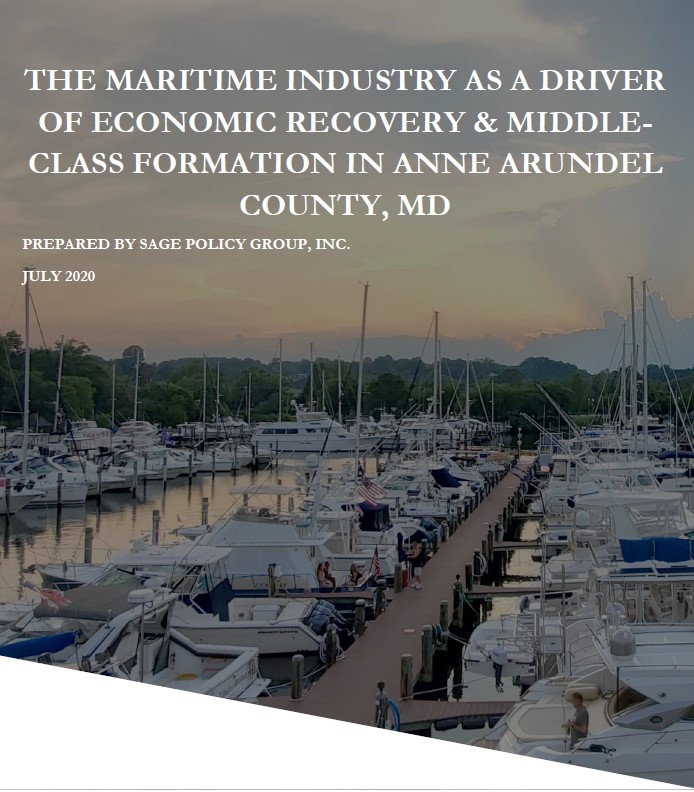Stay up to date on the county

Stay up to date on the county
AAEDC Maritime Economy Report Featured in What’s Up Mag
August 5, 2021
AAEDC’s 2020 Maritime Industry Report, “Maritime Industry as a Driver of Economic Recovery & Middle-Class Formation in Anne Arundel County, MD,” was featured in the following article in What’s Up? Magazine: Rising Tide Lifts All Boats: Success of the Local Maritime Industry and its History.
Discussing the past, present, and future of the industry, the article featured the report’s findings regarding the economic and fiscal benefits generated by the county’s maritime industry:
“Last year, the Anne Arundel County Economic Development Corporation commissioned Sage Policy Group, Inc. to study the economic and fiscal benefits generated by the county’s maritime industry. The report noted that with more than 500 miles of coastline, 300 marinas, and 12,000 boat slips, Anne Arundel County provides better public access to the water than any other county in Central Maryland. That access supports industries ranging from building boats to providing marinas to house them.
The industry’s ability to attract recreational boaters and their spending power to the county also supports jobs and economic activity,” the report stated. The presence of the Coast Guard station on Thomas Point and Naval Academy also add some panache.
Sage determined that Anne Arundel County’s maritime industry directly supports nearly 5,700 jobs and more than $274 million in annual employee compensation. When you figure out where those 5,700 employees spend their earnings, the report estimates that the county’s maritime industry supports 8,600 jobs, $416 million in annual employee compensation, and nearly $1.2 billion in annual economic activity.
To put things in perspective, the Sage report notes that while Anne Arundel County’s maritime industry’s $1.2 billion in annual economic activity is impressive, it’s only about 2.5 percent of the county’s annual gross county product as reported by the U.S. Bureau of Economic Analysis. Still, it’s about 43 times greater than the county’s agriculture industry.
The report concludes that recreational boaters in Anne Arundel County spent $96 million every year on their boats and boating-related activities.”
The article also discussed many of the steps that the report said should be taken to ensure that these impacts expand over the coming years, particularly in the face of the recovery from the viral pandemic:
“But the future of the marine industry in our state capital and in fact all of Maryland depends on several steps that the Sage Group study says should be taken to ensure these impacts expand over the coming years, particularly in the face of the recovery from the viral pandemic.
In focus groups and interviews, maritime stakeholders complained the industry faces a dearth of available labor and that the city, county, and state permitting processes are “overly convoluted, time consuming, and expensive,” and that a decline in Anne Arundel County’s water quality would have negative effects on the industry.
The report advised that the Anne Arundel County Maritime Advisory Board should coordinate efforts to expose youth to the idea of a maritime career through career fairs, vocational training programs, and other educational programs at Anne Arundel Community College (AACC).
Industry stakeholders should participate in training programs like the Marine Trades Association of Maryland’s on-the-job training program. “These programs have shown significant promise in encouraging students who do not intend to attend four-year colleges to enter the maritime industry,” the study reports.
Industry stakeholders should also collaborate with AACC to implement the American Boat and Yacht Council (ABYC) Marine Service Technology Program, a standards-based curriculum that would allow students to earn a marine service technician certificate and digital badge of achievement upon completion, and to create needed credit certificates such as a Dockmaster Certificate or other credentials required for non-skilled trade jobs in the industry.
The Sage Group also recommends that Anne Arundel County should supply AACC with approximately $35,000 to purchase the curriculum package, maintain it, and outfit the workshop necessary to implement the ABYC Marine Service Technology Program.”
To read the full AAEDC Report, click here.
To learn more about Anne Arundel County’s marine industry, visit our Marine Industry Overview page.
SBA’s Shuttered Venue Operators Grant Program Still Taking Applications »
Press Contact
For all media inquiries, please contact:
Victoria Zelefsky
P 410-222-7410
E [email protected]